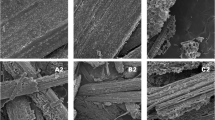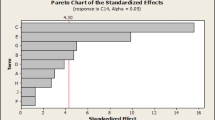Abstract
Agricultural waste products, beech wood and walnut shells, were hydrolyzed at 40°C using mixed crude enzymes produced byPenicillium sp. AHT-1 andRhizomucor pusillus HHT-1.d-xylose, 4.1 g and 15.1 g was produced from the hydrolysis of 100 g of beech wood and walnut shells, respectively. For xylitol production,Candida tropicalis IFO0618 and the waste product hydrolyzed solutions were used. The effects on xylitol production, of adding glucose as a NADPH source,d-xylose and yeast extract, were examined. Finally, a 50% yield of xylitol was obtained by using the beech wood hydrolyzed solution with the addition of 1% yeast extract and 1% glucose at an initial concentration.
Similar content being viewed by others
References
Rolla, G., A. A. Schele, and S. Assev (1987) Plaque formation and plaque inhibition.Dutsch. Zahnarztl. 42: 39–41.
Van Eys, J., Y. M. Wang, S. Chan, S. Tanphaichitr, and S. M. King (1974) Sugar in nutrition: Xylitol as a therapeutic agent in glucose-6 phosphate dehydrogenase deficiency, 8 ed, pp. 613–631 In: H. L. Sipple and K. W. McNatt (eds.). Academic Press, New York, USA.
Pepper, T. and P. M. Olinger (1988) Xylitol in sugar-free confections.Food Technol. 42: 98–106.
FAO (1999) Food and agriculture organization of the United Nations,FAO production yearbook 1999.
Winkelhausen, E. and S. Kuzmanova (1998) Microbial conversion of D-xylose to xylitol.J. Ferment. Bioeng. 86: 1–14.
Rahman, A. K. M. S., S. Kawamura, M. Hatsu, M. M. Hoq, and K. Takamizawa (2001) Physicochemical properties of a novel α-L-arabinofuranosidase fromRhizomucor pusillus HHT-1.Can. J. Microbiol. 47: 67–772.
Rahman, A. K. M. S., N. Sugitani, M. Hatsu, and K. Takamizawa (2003) A role of xylanase, α-L-arabinofuranosidase, and xylosidase in xylan degradation.Can. J. Microbiol. 49: 58–64.
Horitsu, H., Y. Yahashi, K. Takamizawa, K. Kawai, K. Suzuki, and N. Watanabe (1992) Production of xylitol from D-xylose byCandida tropicalis: optimization of production rate.Biotech. Bioeng. 40: 1085–1091.
Yokoyama, S., T. Suzuki, K. Kawai, H. Horitsu, and K. Takamizawa (1995) Purification, characterization and structure analysis of NADPH dependent D-xylose reductase fromCandida tropicalis.J. Ferment. Bioengi. 79: 217–223.
Yahashi, Y., H. Horitsu, K. Kawai, T. Suzuki, and K. Takamizawa (1996) Production of xylitol from D-xylose byCandida tropicalis-the effect of D-glucose feeding.J. Ferment. Bioeng. 81: 148–152.
Bailey, M. J., P. Biely, and K. Poutanen (1992) Interlaboratory testing of methods for assay of xylanase activity.J. Biotechnol. 23: 257–270.
Cho, C. H., M. Hatsu, and K. Takamizawa (2002) The production of D-xylose by enzymatic hydrolysis of agricultural wastes.Water Sci. Technol. 45: 97–102.
Oh, D. K. and S. Y. Kim (1998) Increase of xylitol yield by feeding xylose and glucose inCandida tropicalis.Appl. Microbiol Biotechnol. 50: 419–425.
Kim, Y. S., S. Y. Kim, J. H. Kim, and S. C. Kim (1999) Xylitol production using recombinantSaccharomyces cerevisiae containing multiple xylose reductase genes at chromosomal δ-sequences.J. Biotechnol. 67: 159–171.
Choi, J.-H., K.-H. Moon, Y.-W. Ryu, and J.-H. Seo (2000) Production of xylitol in cell recycle fermentation ofCandida tropicalis.Biotechnol Lett. 22: 1625–1628.
Azuma, M. I., J. Keuchi, R. Kinitani, J. Kato, and H. Ooshima (2000) Increase in xylitol production ofCandida tropicalis.Biotechnol. Lett. 22: 1625–1628.
Chung, Y. S., M. D. Kim, W. L. Lee, Y. W. Ryu, J. H. Kim, and J. H. Seo (2002) Stable expression of xylose reductase gene enhance xylitol production in recombinantSaccharomyces cerevisiae.Enzyme Microb. Technol. 20: 809–816.
Kim, M. D., Y. S. Jeun, S. G. Kim, Y. W. Ryu, and J. H. Seo (2002) Comparison of xylitol production in recombinantSaccharomyces cerevisiae strain harboring XYL1 gene ofPichia stipitis and GRE3 gene ofS. cerevisiae.Enzyme Microb. Technol. 31: 862–866.
Hallborn, J., M. Waldfridsson, U. Airakisinen, H. Ojamo, B. Haln-Hägerdal, M. Penttila, and S. Keränen (1991) Xylitol production by recombinantSaccharomyces cerevisiae Bio/Technology 9: 1090–1095.
Delgenes, J. P., M. C. Escare, J. M. Laplace, R. Moletta, and J. M. Navarro (1998) Biological production of industrial chemicals,i.e. xylitol and ethanol, from lignocellulose by controlled mixed culture.Ind. Crops Products. 7: 101–111.
Cho, C. H., S. Aruga, M. Hatsu, T. Suzuki, K. Kawai, and K. Takamizawa (2000) Development of medium by the combined treatment of steam explosion and chemical decomposition of peanut shells for production of xylitol byCandida tropicalis.J. Japan Soc. Waste Manage. Experts 11: 11–20.
Author information
Authors and Affiliations
Corresponding author
Rights and permissions
About this article
Cite this article
Tran, L.H., Yogo, M., Ojima, H. et al. The production of xylitol by enzymatic hydrolysis of agricultural wastes. Biotechnol. Bioprocess Eng. 9, 223–228 (2004). https://doi.org/10.1007/BF02942297
Received:
Accepted:
Issue Date:
DOI: https://doi.org/10.1007/BF02942297




